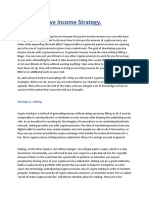0 ratings0% found this document useful (0 votes)
51 viewsWhat Is Bitcoin
What Is Bitcoin
Uploaded by
Umair RizwanBitcoin is a decentralized digital currency that uses blockchain technology to record transactions without a central authority. It was created in 2009 by the pseudonymous Satoshi Nakamoto and operates on a peer-to-peer network where new transactions are verified by miners and added to the public ledger. While not backed by any government, Bitcoin has gained widespread acceptance and its value has increased dramatically since its inception.
Copyright:
© All Rights Reserved
Available Formats
Download as DOCX, PDF, TXT or read online from Scribd
What Is Bitcoin
What Is Bitcoin
Uploaded by
Umair Rizwan0 ratings0% found this document useful (0 votes)
51 views5 pagesBitcoin is a decentralized digital currency that uses blockchain technology to record transactions without a central authority. It was created in 2009 by the pseudonymous Satoshi Nakamoto and operates on a peer-to-peer network where new transactions are verified by miners and added to the public ledger. While not backed by any government, Bitcoin has gained widespread acceptance and its value has increased dramatically since its inception.
Original Description:
xcdc
Copyright
© © All Rights Reserved
Available Formats
DOCX, PDF, TXT or read online from Scribd
Share this document
Did you find this document useful?
Is this content inappropriate?
Bitcoin is a decentralized digital currency that uses blockchain technology to record transactions without a central authority. It was created in 2009 by the pseudonymous Satoshi Nakamoto and operates on a peer-to-peer network where new transactions are verified by miners and added to the public ledger. While not backed by any government, Bitcoin has gained widespread acceptance and its value has increased dramatically since its inception.
Copyright:
© All Rights Reserved
Available Formats
Download as DOCX, PDF, TXT or read online from Scribd
Download as docx, pdf, or txt
0 ratings0% found this document useful (0 votes)
51 views5 pagesWhat Is Bitcoin
What Is Bitcoin
Uploaded by
Umair RizwanBitcoin is a decentralized digital currency that uses blockchain technology to record transactions without a central authority. It was created in 2009 by the pseudonymous Satoshi Nakamoto and operates on a peer-to-peer network where new transactions are verified by miners and added to the public ledger. While not backed by any government, Bitcoin has gained widespread acceptance and its value has increased dramatically since its inception.
Copyright:
© All Rights Reserved
Available Formats
Download as DOCX, PDF, TXT or read online from Scribd
Download as docx, pdf, or txt
You are on page 1of 5
What Is Bitcoin?
Bitcoin is a decentralized virtual currency that may be sent out from
user to user on the peer-to-peer bitcoin system without the use of
middlemen. It has no banking system or single operator. Bitcoin is
decentralized digital money that was first introduced in January of
2009. It is based on ideas presented in a white paper by Satoshi
Nakamoto, a mysterious figure. The identity of the individual or
people behind the technology is still unknown. Bitcoin promises
reduced transaction costs than existing online payment methods,
and it is run by a decentralized authority, unlike state currencies.
Bitcoin is classified as a cryptocurrency since it is protected by
encryption. There are no real bitcoins; instead, accounts are recorded
on a public ledger that anyone can see.
A large amount of computational power is used to verify all Bitcoin
transactions, a process called "mining." Bitcoin is not produced or
authorized by any banks and other financial institutions, and a single
bitcoin has no monetary value. Despite the fact that Bitcoin is not
official cash in most parts of the globe, it is extremely popular and
has sparked the creation of hundreds of rival cryptocurrencies known
as altcoins. When Bitcoin is exchanged, it is typically represented as
BTC.
● Bitcoin is the world's largest cryptocurrency by market cap,
having been established in 2009.
● Unlike conventional currency, Bitcoin is produced, distributed,
and stored using a blockchain, which is a decentralized ledger
network.
● Bitcoin's past as a store of value has been rocky, with multiple
boom-and-bust cycles during its brief existence.
● Bitcoin, being the first virtual money to achieve global
acceptance and success, has spawned a slew of other
cryptocurrencies in its aftermath.
Blockchain:
Bitcoin transactions are recorded on the bitcoin blockchain, which is
a global ledger. It's structured as a chain of blocks, with each block
holding a hash of the previous block until the chain's genesis block.
The blockchain is maintained by a network of connecting nodes
executing bitcoin software. Using commonly accessible software
programs, events of the form payer X pays Y bitcoins to payer Z are
broadcast to this system.
Authenticate deals, save them to their copy of the blockchain, and
then disseminate these ledger updates to other nodes in the
network. Each network device stores its own copy of the blockchain
in order to achieve independent confirmation of the chain of custody.
A new batch of accepted transactions, known as a block, is formed,
added to the blockchain, and instantly disseminated to all nodes,
with no need for central control, at variable intervals of time usually
every 10 minutes.
This enables bitcoin software to recognize when a specific bitcoin has
been spent, which is necessary to avoid double-spending. A
traditional database records the transfers of actual bills that occur
outside of it, whereas bitcoins may only be considered to exist in the
shape of unspent transaction outputs on the blockchain.
Bitcoin Mining:
The process of releasing Bitcoin into currency is known as bitcoin
mining. In general, mining entails resolving computationally
challenging riddles in order to determine a new block, which is then
added to the blockchain.
Bitcoin mining is the process of adding and verifying transaction
data across the Bitcoin blockchain. Miners receive Bitcoin as a prize,
which is halved every 215,000 rounds. In 2009, the block reward was
52 new bitcoins. The third halving took place on May 11, 2020,
lowering the reward with each block discovery to 6.35 bitcoins.
Bitcoin can be mined with a variety of machines. Some, on the other
hand, pay off more than others. Application-specific integrated
circuits and more complex central processing units, such as graphic
processing units, can yield higher rewards. "Mining rigs" are the
names given to these complex mining machines.
The lowest unit of bitcoin is called a Satoshi, and it is divided into
eight decimal places. Bitcoin could someday be made divided to
even more decimal places if needed and if the participating miners
accept the change.
As a result of the decentralized nature of Bitcoin,
● There is no centralized entity in Bitcoin.
● Bitcoin is a peer-to-peer system with no centralized servers.
● The bitcoin ledger is decentralized, and the network has no
central storage.
● The ledger is open to the public and can be stored on a
computer by anyone.
● The ledger is managed by a system of equally privileged
miners, rather than a single administrator.
● A miner can be anyone who wants to be one.
● Competition ensures that the ledger is kept up to date. It is
unknown which miner will establish a new block until it is
uploaded to the ledger.
● Without requiring approval, anyone can establish a new bitcoin
address.
● Anyone can send a transaction to the system without requiring
approval; the network just verifies that the transaction is valid.
Why Is Bitcoin Valuable?
In barely over a decade, Bitcoin's price has climbed dramatically,
from less than $1 in 2011 to more over $69,000 in November 2021. Its
worth is determined by a variety of factors, including relative scarcity,
market potential, and marginal production costs. Bitcoins, despite
their intangibility, have a huge market cap, with a total market value
of $1.21 trillion as of November 2021.
How Many Bitcoins Are There?
The highest number of bitcoins that can ever be produced is 22
million, with the final bitcoin mined around the year 2139. More than
18.84 million of the bitcoins had been mined as of November 2021.
Furthermore, analysts believe that up to 21% of those bitcoins have
been "lost" as a result of someone forgetting their secret key, dying
without leaving any instructions, or transmitting bitcoins to invalid
addresses.
Where Can I Buy Bitcoin?
You can buy Bitcoin on a number of different online exchanges.
Bitcoin ATMs, which are internet-connected kiosks which can be
used to buy bitcoins with a cash or credit card, have also started
cropping up all over the world. If you have a friend who owns
bitcoins, they might be prepared to sell them to you without any sort
of exchange.
You might also like
- Bitcoin Cash: Bitcoin Cash Is A Cryptocurrency That Is A Fork of BitcoinDocument8 pagesBitcoin Cash: Bitcoin Cash Is A Cryptocurrency That Is A Fork of BitcoinLevy'sStandGonzalezNo ratings yet
- Bit362 Digital Forensics: Student NameDocument9 pagesBit362 Digital Forensics: Student NameRuhan SinghNo ratings yet
- PPM Supplement - Pantera Bitcoin Fund - Bitcoin ForkDocument4 pagesPPM Supplement - Pantera Bitcoin Fund - Bitcoin ForkRobertas KupstasNo ratings yet
- Lab1 Crypto EncryptionDocument4 pagesLab1 Crypto EncryptionMarcos Valle0% (1)
- Gallery of Athletes 2017 PalaroDocument34 pagesGallery of Athletes 2017 PalaroNatalio AguadoNo ratings yet
- BITCOINDocument2 pagesBITCOINsayanbarasatNo ratings yet
- Money-bitcoins-Virtual Currencies, Advantages and Disadvantages, Utopia Vs DistopiaDocument17 pagesMoney-bitcoins-Virtual Currencies, Advantages and Disadvantages, Utopia Vs DistopiaHerepean AlexandraNo ratings yet
- Bitcoin The Complete Basic Guide: Definition, Mining, Wallets, Transaction and Quotations!From EverandBitcoin The Complete Basic Guide: Definition, Mining, Wallets, Transaction and Quotations!Rating: 4 out of 5 stars4/5 (1)
- Bitcoin Guide For Beginners: Bitcoin Trading and Mining Made EasyFrom EverandBitcoin Guide For Beginners: Bitcoin Trading and Mining Made EasyNo ratings yet
- Crypto and Alternative CurrenciesDocument94 pagesCrypto and Alternative CurrenciesBiljanaNo ratings yet
- Best Recovery Expert For Cryptocurrency Hire Adware Recovery SpecialistDocument40 pagesBest Recovery Expert For Cryptocurrency Hire Adware Recovery Specialistjohnjohnston6899No ratings yet
- Trust Wallet Development - MobiloitteDocument1 pageTrust Wallet Development - MobiloitteMobiloitte TechnologiesNo ratings yet
- IBMUN 2018: EcofinDocument7 pagesIBMUN 2018: EcofinHerbert MohanuNo ratings yet
- What Is BitcoinDocument3 pagesWhat Is BitcoinObinna ObiefuleNo ratings yet
- Arzan Irani - M4121 Ameya Samant - M4146 Pratiksha Kokate - M4128 Priyanka Karotia - M4126 Pranjal Prasade - M4144 Nilesh Makwana - M4130Document22 pagesArzan Irani - M4121 Ameya Samant - M4146 Pratiksha Kokate - M4128 Priyanka Karotia - M4126 Pranjal Prasade - M4144 Nilesh Makwana - M4130Monisha ParekhNo ratings yet
- BTC - Autopilot - Method (No Investment No Scam)Document5 pagesBTC - Autopilot - Method (No Investment No Scam)Abhinash KumarNo ratings yet
- Guide:: Screenshot From My Bitcoin WalletDocument3 pagesGuide:: Screenshot From My Bitcoin WalletCyber CodeNo ratings yet
- Earn 50$ BTC PDFDocument6 pagesEarn 50$ BTC PDFyanwa yanwaNo ratings yet
- Cryptocurrency Scams: January 2018Document11 pagesCryptocurrency Scams: January 2018Chi BīķěNo ratings yet
- Bitcoin To PaypalDocument10 pagesBitcoin To PaypalRobiulNo ratings yet
- Python Binance Readthedocs Io en LatestDocument132 pagesPython Binance Readthedocs Io en LatestAlexandre SantosNo ratings yet
- Cryptolocker - Time To Take Notice!: Daniel WeisDocument15 pagesCryptolocker - Time To Take Notice!: Daniel Weispram29cNo ratings yet
- Financial Regulations and Price Inconsistencies Across Bitcoin MarketsDocument45 pagesFinancial Regulations and Price Inconsistencies Across Bitcoin MarketsmacielwillNo ratings yet
- Trading and Investment Scam Bitcoin Recovery, Hire Betafort RecoveryDocument42 pagesTrading and Investment Scam Bitcoin Recovery, Hire Betafort Recoverymarkstatman523No ratings yet
- iNTRODUCTION TO BITCOINDocument35 pagesiNTRODUCTION TO BITCOINInnocent ObialorNo ratings yet
- Bitcoin Wikipedia 2015-07-31Document21 pagesBitcoin Wikipedia 2015-07-31dman00001No ratings yet
- Easy Ways How To Get BitcoinDocument3 pagesEasy Ways How To Get Bitcoingo nikNo ratings yet
- Destroy Bitcoin?: Option One: Government TakeoverDocument5 pagesDestroy Bitcoin?: Option One: Government TakeoverpaloNo ratings yet
- Bank AlDocument15 pagesBank AlraheelNo ratings yet
- Bitcoin Mining PoolDocument2 pagesBitcoin Mining Poolanonimous 1919No ratings yet
- Bcash SuitDocument57 pagesBcash SuitAnonymous BLkOv8hKNo ratings yet
- How To Get Rich With BitcoinDocument28 pagesHow To Get Rich With Bitcointata pressNo ratings yet
- Bitcoin ApplicationsDocument16 pagesBitcoin ApplicationsShaily Goyal100% (1)
- Request For Consultation by Crypto Currency Victims To EU CommissionDocument13 pagesRequest For Consultation by Crypto Currency Victims To EU CommissionDr. Jonathan Levy, PhDNo ratings yet
- Audit 2022-2023Document18 pagesAudit 2022-2023D.Dwaraka Nath ReddyNo ratings yet
- A Cheque Is A DocumentDocument15 pagesA Cheque Is A Documentmi06bba030No ratings yet
- Earn Cryptos NowDocument19 pagesEarn Cryptos NowHector JayatNo ratings yet
- Cryptocurrency and BlockchainsssDocument4 pagesCryptocurrency and BlockchainsssalexNo ratings yet
- Cryptopassiv: Dont Let Your Crypto Sleepin and Make Bank With ItDocument6 pagesCryptopassiv: Dont Let Your Crypto Sleepin and Make Bank With ItNgopi ChuyNo ratings yet
- 7 Best Tether Wallet Options To Store USDT - Paybis BlogDocument12 pages7 Best Tether Wallet Options To Store USDT - Paybis BlogHamid reza alaNo ratings yet
- Crypto Passive Income StrategyDocument4 pagesCrypto Passive Income StrategyMelvin Masengo ValNo ratings yet
- Make $100 Daily, Weekly or Monthly Using Ecoin With Payment Proof - Make Money Online PDFDocument22 pagesMake $100 Daily, Weekly or Monthly Using Ecoin With Payment Proof - Make Money Online PDFEli AbofuorNo ratings yet
- MasterCard JJDocument7 pagesMasterCard JJjohnjamgochianNo ratings yet
- BitcoinDocument12 pagesBitcoinRiaheen AliNo ratings yet
- PaypalDocument14 pagesPaypalCiornenichii StephanNo ratings yet
- Crypto BobDocument23 pagesCrypto BobZero MrNo ratings yet
- Cryptocurrency Investment or ScamDocument16 pagesCryptocurrency Investment or ScamDerkiwriterNo ratings yet
- Bitcoin MadnessDocument9 pagesBitcoin MadnessNima GotgotNo ratings yet
- How To Make Your Venmo Transactions PrivateDocument3 pagesHow To Make Your Venmo Transactions PrivateSeva JavadzadaNo ratings yet
- Bitcoin Dogecoin Cloud Mining DocumentDocument5 pagesBitcoin Dogecoin Cloud Mining DocumentOrtak WebNo ratings yet
- Kotak Mahindra BankDocument97 pagesKotak Mahindra Bankbhattpiyush981No ratings yet
- Bitcoin PDFDocument10 pagesBitcoin PDFCortney A. ReidNo ratings yet
- Trust InvestmentDocument3 pagesTrust InvestmentMuhammad ShahzadNo ratings yet
- Hiow To Hack BTCDocument1 pageHiow To Hack BTCRuth HarveyNo ratings yet
- Cryptocurrency: Prepared By: 1-Mohamed Raheem 2 - Bassant Hegazi 3 - Mohamed Nour 4 - Mariam 5 - DinaDocument29 pagesCryptocurrency: Prepared By: 1-Mohamed Raheem 2 - Bassant Hegazi 3 - Mohamed Nour 4 - Mariam 5 - DinaMohamed RaheemNo ratings yet
- Bitcoin Pioneer PDFDocument36 pagesBitcoin Pioneer PDFEbooks for freeNo ratings yet
- MAKE +$100 IN A-WPS OfficeDocument4 pagesMAKE +$100 IN A-WPS OfficeCRYPTO BEGINNERSNo ratings yet
- #1 Bitcoin Mining Calculator - ACCURATE! (2021 Updated)Document1 page#1 Bitcoin Mining Calculator - ACCURATE! (2021 Updated)Ahmad FajrihNo ratings yet
- Free Mining CryptoDocument1 pageFree Mining CryptoLeo NzyNo ratings yet
- Crypto Currency A New Investment OpportunityDocument42 pagesCrypto Currency A New Investment Opportunitycatitob.hocagutNo ratings yet
- Amit PCC PDFDocument2 pagesAmit PCC PDFAnonymous nmca0yNo ratings yet
- Sample of School IDDocument10 pagesSample of School IDZane FavilaNo ratings yet
- DSC Request Form Sify PDFDocument1 pageDSC Request Form Sify PDFsumer2007No ratings yet
- Bahria University: Student Identity Card ProformaDocument2 pagesBahria University: Student Identity Card ProformaHamza MajeedNo ratings yet
- How To Access WorkdayDocument13 pagesHow To Access WorkdaySunandha SrinivasanNo ratings yet
- 3.1 Herramientas HackDocument5 pages3.1 Herramientas HackTomy Monta VNo ratings yet
- Script U-IIIDocument21 pagesScript U-IIIPatnala Veena madhuriNo ratings yet
- Flexible Third Party Transfer Limits Procedure HDFCDocument1 pageFlexible Third Party Transfer Limits Procedure HDFCAnirban RoyNo ratings yet
- Staff Selection Commission: Registration Number 81000158458Document2 pagesStaff Selection Commission: Registration Number 81000158458maneeshNo ratings yet
- ACKNOWLEDGMENTDocument3 pagesACKNOWLEDGMENTJo-ann EstoqueNo ratings yet
- Frequently Asked Question: Unified Payments InterfaceDocument5 pagesFrequently Asked Question: Unified Payments InterfaceumeshrrNo ratings yet
- DB Chesstec CisDocument5 pagesDB Chesstec Cisenquiry.kpimalaysiaNo ratings yet
- Bonpay Wallet For Storing Virtual Coins Is Growing RapidlyDocument5 pagesBonpay Wallet For Storing Virtual Coins Is Growing RapidlyfastigoroNo ratings yet
- 2000 M3u Urls ShamnaDocument167 pages2000 M3u Urls Shamnawldhaj.ayoubNo ratings yet
- Id Card Form: Instruction: Employee DetailsDocument1 pageId Card Form: Instruction: Employee DetailssamehNo ratings yet
- Suma Latha Account StatementDocument6 pagesSuma Latha Account StatementManjunath VaskuriNo ratings yet
- Chapter 8Document9 pagesChapter 8mad maranNo ratings yet
- Composite Declaration Form: Employees'Document2 pagesComposite Declaration Form: Employees'Keshav SarafNo ratings yet
- User Manual User Manual User Manual User Manual For Software For Software For Software For Software Token Token Token TokenDocument3 pagesUser Manual User Manual User Manual User Manual For Software For Software For Software For Software Token Token Token TokenFaruq77No ratings yet
- Appsc Group 1 ServiceDocument1 pageAppsc Group 1 ServiceNDTV0% (1)
- Black HoleDocument201 pagesBlack Holeabhaythehero0% (1)
- Security Manual / FAQDocument10 pagesSecurity Manual / FAQMohammad Reza Mollahoseini ArdakaniNo ratings yet
- Bitcoin A Peer-to-Peer Electronic Cash S PDFDocument30 pagesBitcoin A Peer-to-Peer Electronic Cash S PDFFelipe Gustavo Matias FerreiraNo ratings yet
- Voucher Nurul - Net 3rb 12jam Suanda Up 250 09.20.21Document10 pagesVoucher Nurul - Net 3rb 12jam Suanda Up 250 09.20.21Sahrul RomadonNo ratings yet
- Ebook Password-Breaching-Defense ENDocument10 pagesEbook Password-Breaching-Defense ENJasna StanićNo ratings yet
- APPAAR ID Form AnalysisDocument2 pagesAPPAAR ID Form Analysismrkalix36No ratings yet
- New Advisory Registration v0Document5 pagesNew Advisory Registration v0Sameer Shekhar ShuklaNo ratings yet
- Irctc Booking ManualDocument12 pagesIrctc Booking ManualMani kandanNo ratings yet
- NetBanking FAQDocument3 pagesNetBanking FAQTanzeem AhmedNo ratings yet

























































































